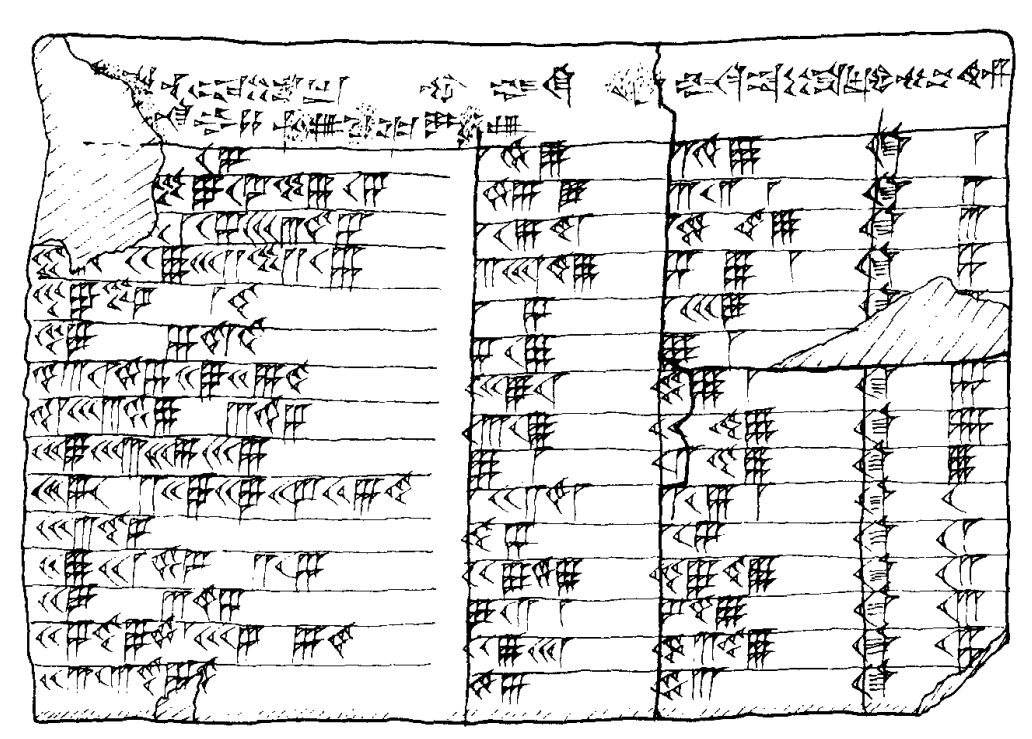Because of the way mathematical ideas build on other mathematical ideas, the order in which these ideas were discovered/invented is often the same as the order in which they are taught.
All humans typically start where humanity (is thought to have) started, with counting objects and identifying simple shapes. From there, we begin making calculations. Modern learning differs from historical development here in being formal from the very beginning, as well as in introducing the abstract ideas of zero and negative numbers earlier. Early mathematics was pragmatic, while modern early math education is oriented towards further learning of more and more abstract concepts.
Counting and Cardinality
- Know number names and the count sequence.
- Count to tell the number of objects.
- Compare numbers.
Operations and Algebraic Thinking
- Understand addition as putting together and
adding to, and understand subtraction as
taking apart and taking from.Number and Operations in Base Ten
- Work with numbers 11–19 to gain foundations
for place value.Measurement and Data
- Describe and compare measurable attributes.
- Classify objects and count the number of
objects in categories.Geometry
- Identify and describe shapes.
- Analyze, compare, create, and compose
shapes.Grade K Overview, Common Core State Standards for Mathematics p. 10
One of the oldest mathematical texts we know of is Plimpton 322, an Ancient Babylonian carved tablet from c. 1900-1600 BCE (Friberg 1981, p. 280). The tablet is a numerical table, possibly used for teaching purposes, with calculations involving the dimensions of rectangles (Britton et al. 2011).

Similarly old mathematical texts have been found in Egypt:
The earliest extant mathematical text from Egypt is the Rhind papyrus (c. 1650 [BCE]). It and other texts attest to the ability of the ancient Egyptians to solve linear equations in one unknown.
Britannica
By the time of Euclid c. 300 BCE, a more theoretical approach had developed involving axioms and theorems (O’Connor and Robertson 1999). This is often not fully developed until high school. Euclid is known for his Elements which developed synthetic geometry and other mathematical topics.
During high school, students begin to formalize their geometry experiences from elementary and middle school, using more precise definitions and developing careful proofs.
High School – Geometry, Common Core State Standards for Mathematics p. 74
Basic arithmetic and geometry is followed by algebraic ideas. This was codified by Muḥammad ibn Mūsā al-Khwārizmī in his book al-Kitāb al-mukhtaṣar fī ḥisāb al-jabr wa’l-muqābala in the 9th century CE. The name al-Khwārizmī is the origin of the term “algorithm” and the al-jabr in the book’s title is the origin of the term “algebra.” (Britannica.)
By middle school, students learn about the cartesian plane, named for René Descartes (1596-1650). Descartes was instrumental in the development of analytic geometry, the connection between algebra and geometry that enables us to graph functions (O’Connor and Robertson 2014). By high school, students are well into the 17th century in terms of functions and graphing.
Algebra II covers many topics that were developed in the 17th-19th centuries, including logarithms, Euler’s number, and matrices.
The first to use the term ‘matrix’ was Sylvester in 1850. Sylvester defined a matrix to be an oblong arrangement of terms and saw it as something which led to various determinants from square arrays contained within it.
O’Connor and Robertson 1996
Calculus is generally the zenith of school mathematics. It is commonly taught but beyond what the standards require. While it was initially developed in the late 17th century, it took time to reach its modern state.
After Newton and Leibniz the development of the calculus was continued by Jacob Bernoulli and Johann Bernoulli. However when Berkeley published his Analyst in 1734 attacking the lack of rigour in the calculus and disputing the logic on which it was based much effort was made to tighten the reasoning. Maclaurin attempted to put the calculus on a rigorous geometrical basis but the really satisfactory basis for the calculus had to wait for the work of Cauchy in the 19th Century.
O’Connor and Robertson 1998
School math essentially ends by 1900. After this point in education (entering college), the curriculum doubles back to cover topics in more detail or topics that were skipped. An undergraduate math major is likely to learn little to no contemporary mathematics, which is generally the domain of mathematicians.
References
Common Core State Standards for Mathematics. https://www.thecorestandards.org/wp-content/uploads/Math_Standards1.pdf
Britannica (2023). Algebra. https://www.britannica.com/science/algebra
Britton, J. P., Proust, C., & Shnider, S. (2011). Plimpton 322: a review and a different perspective. Archive for History of Exact Sciences, 65(5), 519–566. doi:10.1007/s00407-011-0083-4
Friberg, J. (1981). Methods and traditions of Babylonian mathematics: Plimpton 322, Pythagorean triples and the Babylonian triangle parameter equations. Historia Mathematica, 8(3), 277-318. doi:10.1016/0315-0860(81)90069-0
O’Connor, J. J. and Robertson, E. F. (1996). Matrices and determinants. MacTutor. https://mathshistory.st-andrews.ac.uk/HistTopics/Matrices_and_determinants/
O’Connor, J. J. and Robertson, E. F. (1998). A history of the calculus. MacTutor. https://mathshistory.st-andrews.ac.uk/HistTopics/The_rise_of_calculus/
O’Connor, J. J. and Robertson, E. F. (1999). Euclid of Alexandria. MacTutor. https://mathshistory.st-andrews.ac.uk/Biographies/Euclid/
O’Connor, J. J. and Robertson, E. F. (2014). René Descartes. MacTutor. https://mathshistory.st-andrews.ac.uk/Biographies/Descartes/
